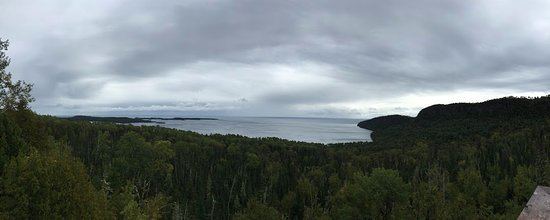Country United States ZIP code 55605 Elevation 192 m | Time zone Central (CST) (UTC-6) Area code(s) 218 Local time Saturday 3:02 AM | |
 | ||
Weather 2°C, Wind NW at 11 km/h, 88% Humidity | ||
Grand Portage is an unincorporated community in Cook County, Minnesota, United States; located on Grand Portage Bay of the North Shore of Lake Superior.
Contents
Map of Grand Portage, MN 55605, USA
Minnesota Highway 61 serves as a main route in the community.
Grand Portage is located 34 miles northeast of the city of Grand Marais; and 5 miles southwest of the Canada–United States border.
The unincorporated community of Grand Portage and the Grand Portage Indian Reservation are both located within Grand Portage Unorganized Territory of Cook County (population 565).
The Grand Portage National Monument is located adjacent to the community. Grand Portage State Park is nearby on the banks of the Pigeon River.
Mount Josephine (elevation 1,315) is immediately northeast of Grand Portage (elevation 630).
History
Beginning in the 17th century, Grand Portage became a major center of the fur trade. See Canadian Canoe Routes (early). It was at the point where a major canoe fur trade route of the voyageurs left the great lakes. It was so named because the route began with a huge 9 mile portage. A portage is a place where the canoes and equipment are carried over land. The French established this trade with the Native Americans until the British took it over in the 18th century after the Seven Years' War. The North West Company established the area as its regional headquarters. Soon Grand Portage became one of Britain's four main fur trading posts, along with Niagara, Detroit, and Michilimackinac. Even after the American Revolutionary War and victory by the rebellious colonists, the British continued to operate in the area. Under the Treaty of Paris in 1783, Britain had to cede former territory to the United States, including this area.
Finally with the signing of the Jay Treaty in 1796, defining the northern border between Canada and the U.S., British traders planned to move from Grand Portage. They wanted to avoid the taxes the U.S. put on their operations, in its effort to encourage American traders instead. In 1802, the traders planned to move north to create a new center, what they called Fort William. In 1803, following the Louisiana Purchase, in which the U.S. acquired the lands to the west of Grand Portage, the British finally moved from Grand Portage to the new post in Canada. The North West Company moved its headquarters northward to what they named Fort William. After British fur traders abandoned the area, it rapidly declined economically until fisheries and logging became popular in the 19th century.
Geography
The community of Grand Portage is located 34 miles northeast of Grand Marais; and 6 miles southwest of the Canada–US border. Grand Portage is 146 miles northeast of Duluth; and 43 miles southwest of Thunder Bay.
Grand Portage is the home of Grand Portage Lodge and Casino.
The island of Isle Royale in Lake Superior is located 15 miles east of the port of Grand Portage. The island and the 450 surrounding smaller islands make up Isle Royale National Park. The island of Isle Royale is forty-five miles long and 9 miles wide. The Sea Hunter, Voyageur II, and Wenonah passenger ferries all run out of Grand Portage and travel to the port of Windigo on the western end of Isle Royale. The ferries pass by Rock of Ages Lighthouse near Windigo. The Voyageur II passenger ferry also travels further to the port of Rock Harbor on the eastern end of Isle Royale. Scheduled toll ferry service from Grand Portage to Isle Royale runs from May to October.
